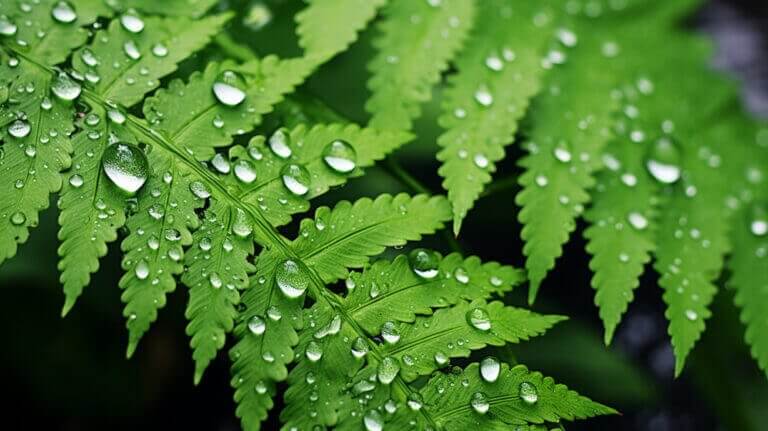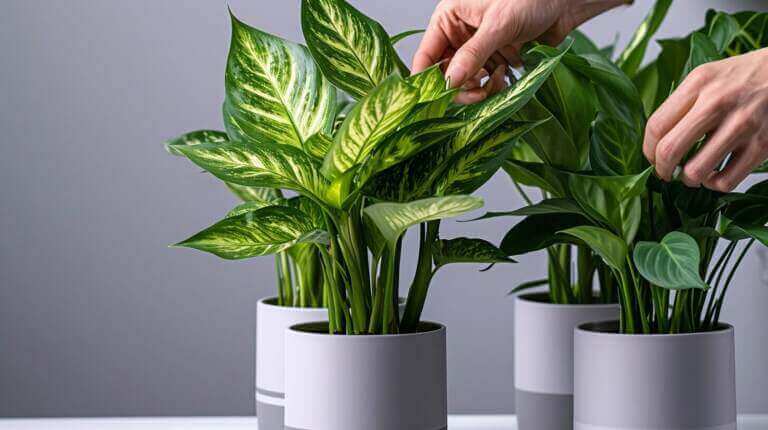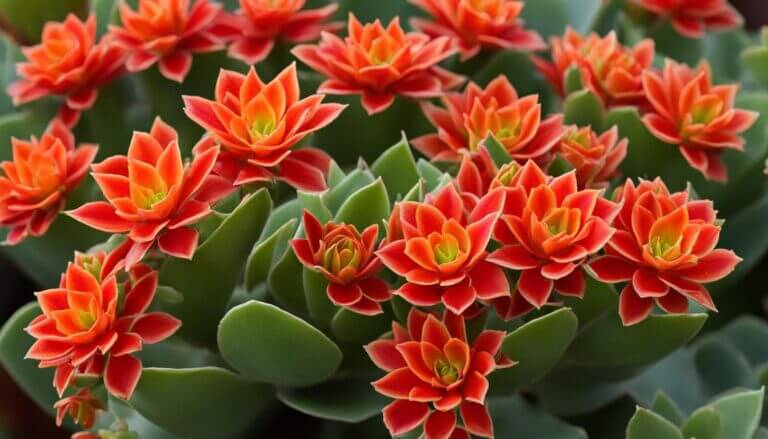Monstera plants, commonly known as Swiss Cheese plants, are beloved for their large, fenestrated leaves that add a touch of tropical beauty to any garden or indoor space. However, if you notice your Monstera’s leaves starting to curl and wrinkle, it’s a sign that something may be amiss in their environment. Understanding the causes of leaf curl and implementing the right solutions can help restore your Monstera to its vibrant, healthy state.
Key Takeaways:
- Wrinkled and curling leaves are common signs of stress or issues with the Monstera plant’s environment.
- Inward curling may indicate watering issues, lack of humidity, or insect infestation.
- Downward curling is often a sign of heat stress or underwatering.
- Crinkled leaves are typically caused by underwatering or low humidity.
- Leaf curl can also be influenced by factors such as sunlight exposure, humidity levels, sudden temperature changes, soil conditions, and pests/diseases.
Identifying and Addressing Watering Issues
Watering plays a crucial role in the health of your Monstera plant. Both underwatering and overwatering can lead to leaf curl, so it’s important to find the right balance. Here are some tips to help you identify and address watering issues:
- Check the soil moisture: Feel the top few inches of soil with your fingers. If it feels wet and hasn’t dried out in a few days, it may be a sign of overwatering. On the other hand, if the soil feels dry several inches down, your plant may be underwatered.
- Use a moisture meter: For a more accurate assessment of soil moisture, consider using a moisture meter. This simple tool can help you determine whether your Monstera needs water or if it’s already too wet.
- Adjust your watering schedule: Based on the soil moisture and the needs of your plant, adjust your watering schedule accordingly. Remember that different environmental conditions may affect how often you need to water your Monstera.
- Ensure proper drainage: Adequate drainage is essential to prevent overwatering. Make sure your Monstera’s pot has drainage holes at the bottom and use well-draining soil to promote proper water flow.
- Consider bottom watering: Instead of watering from the top, you can try bottom watering. This involves placing your plant’s pot in a tray or saucer filled with water and allowing it to soak up moisture from the bottom. Bottom watering can help prevent waterlogging and ensure thorough hydration.
By paying attention to your Monstera’s watering needs and making adjustments as necessary, you can help prevent leaf curl and promote healthy growth.
Table: Signs of Underwatering and Overwatering
| Signs of Underwatering | Signs of Overwatering |
|---|---|
| – Dry soil several inches down | – Wet soil that hasn’t dried out in a few days |
| – Wilting leaves | – Yellowing leaves |
| – Crispy or brown leaf edges | – Mushy or rotting roots |
| – Slow growth | – Foul smell from the soil |
Understanding the signs of underwatering and overwatering can help you determine the best course of action for your Monstera. Remember to always assess the soil moisture and make adjustments to your watering routine accordingly.
Managing Light, Heat, and Humidity Levels
To ensure healthy growth and prevent leaf curl in your Monstera plant, it is crucial to manage the light, heat, and humidity levels. Here are some key considerations:
Light Requirements:
Monstera plants thrive in bright, indirect light. While they can tolerate some direct sunlight, excessive exposure can lead to leaf curl and scorching. If your plant is receiving too much direct sun, consider moving it further away from the light source or filtering the light with a sheer curtain. Maintaining the ideal balance of light is essential for the overall health of your Monstera.
Temperature:
The ideal temperature range for Monstera plants is between 65°F and 85°F. They can tolerate slightly cooler temperatures down to 55°F. Avoid placing your Monstera near cold drafts, radiators, or air conditioning vents, as sudden temperature changes can cause heat stress and leaf curl. Creating a stable and comfortable temperature environment is beneficial for the well-being of your plant.
Humidity:
Monstera plants thrive in high humidity levels of 60% to 80%. Insufficient humidity can lead to leaf puckering and curling. To increase humidity, consider misting the leaves daily or placing a humidifier near the plant. Another effective method is placing the plant on a water or pebble tray. These techniques help create a humid microclimate around the plant, promoting healthy leaf development.
By effectively managing the light, heat, and humidity levels, you can provide your Monstera plant with optimal growing conditions, reducing the risk of leaf curl and ensuring its overall well-being.
| Light Requirements | Temperature | Humidity |
|---|---|---|
| Bright, indirect light | Ideal range: 65°F – 85°F | Ideal range: 60% – 80% |
| Tolerates some direct sunlight | Tolerates down to 55°F | Increase humidity through misting or using a humidifier |
| Filter excess sunlight with a sheer curtain | Avoid sudden temperature changes | Use water or pebble trays to create a humid microclimate |
Addressing Soil Conditions and Nutrient Deficiencies
Soil conditions play a crucial role in the health of your monstera plant. One common issue is compacted soil, which can result from neglecting to repot your plant or using a pot without proper drainage. When the soil becomes compacted, water cannot drain properly, leading to moisture retention and potential leaf curl. To address this, consider repotting your monstera into well-aerated soil and ensure the new pot has adequate drainage.
Nutrient deficiencies can also contribute to leaf curl in monsteras. Three key nutrients to pay attention to are phosphorus, potassium, and nitrogen. A deficiency in phosphorus can cause curling and discoloration of the lower leaves, while a potassium deficiency may result in curling and discoloration of the leaf tips. Nitrogen deficiency, on the other hand, can lead to yellowing and inward curling of the lower leaves. To combat these deficiencies, regular fertilization is essential. Use a balanced fertilizer or one specifically formulated for monsteras, and adjust your fertilizing routine based on the specific nutrient needs of your plant.
To accurately diagnose any nutrient deficiencies, consider conducting a soil test. This will provide you with valuable insights into the nutrient composition of your soil and allow you to make targeted adjustments to your fertilization routine. By addressing soil conditions and nutrient deficiencies, you can help promote healthy growth and prevent leaf curl in your monstera plant.
FAQ
What are the causes of leaf curling in monstera plants?
Leaf curling in monstera plants can be caused by various factors such as watering issues, heat stress, low humidity levels, compacted soil, and nutrient deficiencies.
How can I identify if my monstera is underwatered or overwatered?
You can check the soil moisture by feeling the top few inches of soil and using a moisture meter for accuracy. If the soil feels wet and hasn’t dried out in a few days, it may indicate overwatering. If the soil feels dry a few inches down, it may suggest underwatering.
How can I adjust my watering schedule for my monstera?
It’s important to assess the soil moisture and adjust your watering schedule accordingly. Ensure adequate drainage in the pot to prevent overwatering. Bottom watering can help provide thorough hydration without waterlogging the soil.
What should I do if my monstera is receiving too much direct sunlight?
If your monstera is receiving excessive direct sun, you can move it further away from the light source or filter the light with a sheer curtain.
What is the ideal temperature range for a monstera plant?
The ideal temperature range for a monstera plant is between 65F and 85F. Avoid placing the plant near cold drafts, radiators, or air conditioning vents that can cause temperature extremes and heat stress.
How can I increase the humidity for my monstera plant?
You can increase humidity by misting the leaves daily, using a humidifier near the plant, or placing the plant on a water or pebble tray.
How can I address soil conditions that may be contributing to leaf curl?
If the soil is compacted, it can lead to improper water drainage and cause leaf curl. Repotting the plant into well-aerated soil and a pot with proper drainage can help alleviate compacted soil issues.
How can I address nutrient deficiencies in my monstera plant?
Regular fertilization is important to ensure the plant receives the necessary nutrients. Use a balanced fertilizer or one specifically formulated for monsteras. Conduct a soil test to determine nutrient deficiencies and adjust your fertilizing routine accordingly.







